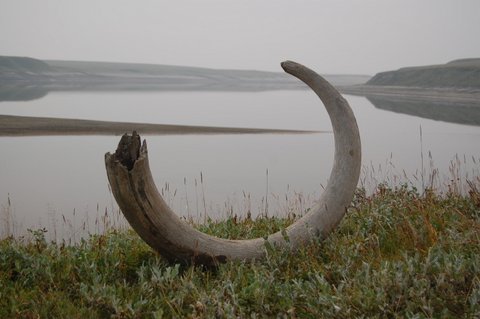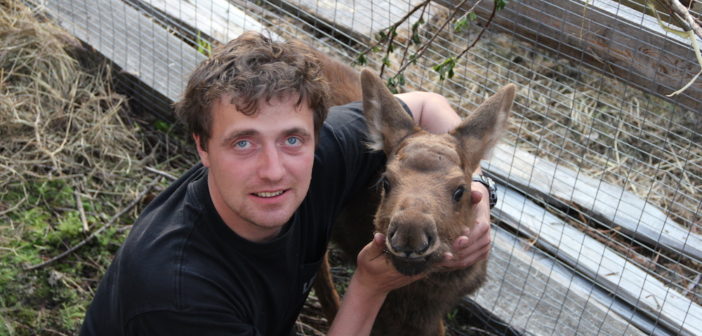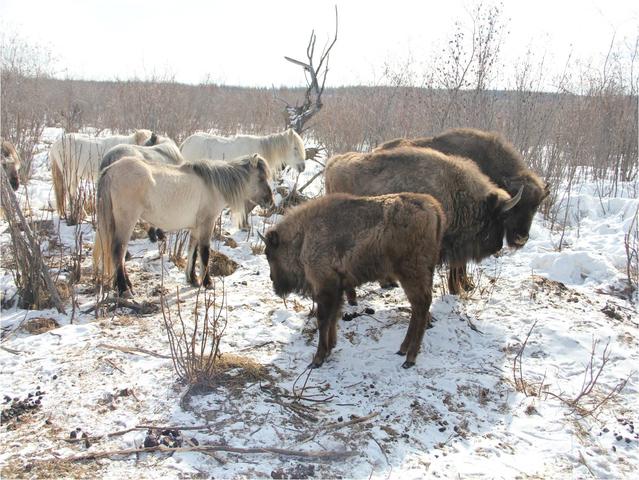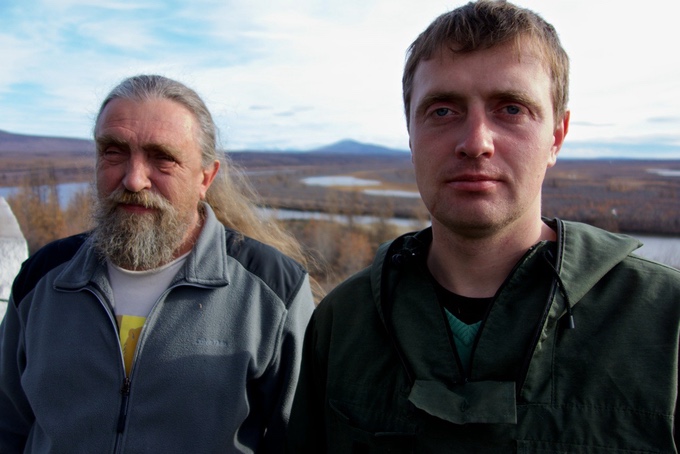Located in the remote tundra of northern Siberia, Pleistocene Park is a one-of-a-kind effort to recreate an extinct ecosystem as it existed tens of thousands of years ago. Founded by environmental scientist Sergey Zimov and currently run by his son Nikita, Pleistocene Park seeks to repopulate the tundra with animal species which once dwelt in the region, as well as introduce new ones filling the niches of species now extinct. Its work is based in the philosophy of Sergey Zimov’s Wild Field Manifesto, a provocative text detailing humankind’s evolutionary origins in the prehistoric steppes, followed by humans’ gradual destruction of crucial steppe ecosystems worldwide.
In challenging conventional views of human history and our relationship to the natural world, and seeking to reverse the impact of millennia of human-driven ecological destruction, Pleistocene Park offers a unique approach to protecting wild animals and the environment. Animal People is honored to have had the opportunity to interview Nikita Zimov, the director of Pleistocene Park, and obtain a deeper understanding of the Park’s philosophy and ambitions, its approach to animal welfare, and the implications for conservation efforts elsewhere in the world.
Q: What was the inspiration for Pleistocene Park?
A: There were multiple inspirations for the Park, and not all of them came simultaneously. However, the first was rather ground based. The idea came to my father when I was very small, probably just born. If you are ever in this part of the Arctic, you will be surprised at how horrible this terrain is to walk on. Tussock tundra, dense shrubs, everything is wet. A few years ago I made a plan to walk 15 kilometers to the park, as no other options were available since the rivers had just frozen, making boats impossible, and snowmobiles were not yet available either. What seemed to be easy as shown on the map took me two full days to walk. And I keep myself in good physical shape and have walked this terrain all my life.
When my father arrived in the Arctic during the late 70s as a student, he was surprised with how few animals he encountered in this seemingly abandoned place, other than billions of mosquitoes. So first came dissatisfaction with modern ecosystems. Then he noticed two things. Everywhere disturbance had taken place – due to towns, farms, fires, or crawling transporters crossing the tundra – all the vegetation was replaced with grasses. You can see a crawling transporter path in the tundra for many years, because of the vegetation change in the tread marks. It takes quite some time for moss and evergreen shrubs to take over the grasses again.
Secondly, everywhere rivers or lakes had eroded the permafrost, on the shore could be found numerous bones of different Pleistocene herbivores. There were no formal analyses back then, but prehistoric bones found in the tundra are orders more abundant than bones of modern animals you can find in the local forest. So it was clear that there were more animals in the past, though it’s only been in the last few years that we can estimate animal density during the Pleistocene with precision.
So basically, the idea for the Park was forged from these three observations: the tough and poor local environment, how easily grasses take over after disturbance, and the abundance of grass eating animals in this place 20,000 years ago.
It was at least a decade later that we started thinking about how this ecosystem can help fight global warming.
What is the project’s core philosophy and agenda?
To learn about our core philosophy in detail, you should read the Wild Field Manifesto. It is basically a philosophical text describing the historical interaction between humans and the high productive steppe ecosystem[1] we’re trying to revive.
In short, humans as a species evolved in the steppe ecosystem, and as soon as they developed enough, they destroyed this ecosystem. After that, humankind started creating its own artificial steppe ecosystems, though many times less efficient and productive than the original wild lands. Artificial steppes (farms and pastures) are very picky in terms of climate and soil conditions. And still there are lots of places in the world which people don’t use, or use very inefficiently, but those territories had steppes with numerous animals in the past. So, we propose to recover these ecosystems in places which people aren’t currently using (humans won’t give away anything else anyway). This will give a direct benefit to local people, but also it will be profitable in terms of combating climate change – increasing albedo[2] and carbon absorption, and decreasing methane production and permafrost degradation (in the case of the Arctic region).
What we do is to make our planet a better place for humans, and to recover how our ancestors related to steppe ecosystems in the past.
Pleistocene Park is currently raising money via Kickstarter to acquire a new population of bison and yaks to introduce to the park. How will animal welfare factor into the project? Who are the suppliers: farms, zoos, wildlife refuges, etc.? How will you provide for the animals’ needs and comfort during the journey? What measures will you take to help them adjust to their new environment with minimal stress or danger? And will their introduction to Pleistocene Park displace any animals currently occupying the habitat?
We need more herbivores which can feed on shrubs, such as bison and yaks. We have a limited number of pastures in the park, though they are growing slowly. Yaks are a cold adapted species and they lived in Yakutia in the past. This animal is rather abundant, and easy to buy in Russian regions north of Mongolia. So it makes perfect sense to try to adapt them to Pleistocene Park. Bison were one of the main four species living in the mammoth steppe ecosystems in the past. So introducing them has always been a top priority. Price, availability and transportation have been the main complications limiting our ability to acquire these species in large numbers.
The yaks will come from Buryatian farmers. They live semi-wild north of Lake Baikal, where the native people keep them for meat. With the bison it is still unsettled from where we will acquire them. I had an agreement with some owners, but after the beginning of our Kickstarter campaign their operation turned out to be a scam, so now I’m looking for alternative options.
The expedition we plan to make is a long journey, and of course we are very concerned with how to make sure all of the animals get to the park safely. It is simply way too expensive to lose any of them. So next month I will work intensively on preparing big containers for animal transportation. We will create individual cells for every animal, making sure they won’t hurt each other. We will make enough doors and windows to allow access to fresh air, water, and enough forage. We will drive for five hours in the morning, give two hours’ rest, and then drive for another five hours, so the animals will have enough time to rest. We will go north, so temperatures won’t be extremely hot during the trip. I am hiring a veterinarian to join me on the trip. I will drive in a separate jeep guiding the other vehicles.
Adaptation to the park is another matter. Firstly, I will not transport babies or young individuals. Three years old is the minimum age. In my experience babies can barely adapt to the new place, while adults do well. Mostly I am worried for the first autumn. Winter in the park comes earlier than these animals will be used to. So this summer, we will create a shelter for them to gather in during the winter to hide from wind and extreme low temperatures. We’re already gathering construction materials for that. Of course the second key to a high survival rate is having enough forage. We are already gathering forage supplies, and will bring enough in the autumn. After the trip, our veterinarian will stay for a full time job in the park, to tend to the animals.
No, these animals will not take anyone’s niche. It is a barren place to begin with. Plus we have lots of land, and can separate it in case some animals will not live peacefully together.
I understand that once the technology is developed to do so, Pleistocene Park seeks to resurrect extinct species like woolly mammoths using genetic engineering. There is of course a great deal of controversy surrounding the ethics of genetic engineering. Some believe it is inherently wrong for humans to tamper with the DNA of natural organisms. Others are concerned about the legal implications of companies patenting new organisms they create. And from an animal welfare perspective, there is the issue of the animals sacrificed to develop the technology. Chances are that attempts to engineer, say, a woolly mammoth will result in many unhealthy animals born to suffer and die before a healthy mammoth is produced who can survive in the wild. How would you answer ethical objections such as the above? Is it necessary to fill the niche once occupied by mammoths, and is genetic engineering really the only means of doing so?

Mammoth tusk uncovered in Taymyr, Siberia (photo credit Johanna Anjar, www.anjar.nu)
I don’t do mammoth cloning. Cloning mammoths is not in our plan for the future. Some other people are trying to do that. They need us to justify their work, and all the media talk about mammoths to attract readers and viewers. Our actual work is more scientific and somewhat less exciting. My work is to bring living animals to the park, make sure they adapt, and see them transform the landscape, keep permafrost frozen and fulfill other ecologically profitable duties. Our work started before people even started thinking about doing any mammoth cloning research. So all these questions should be addressed to George Church or other groups which actually work on mammoth cloning.
If someone should knock on my door in the future and say that he brought me a mammoth, I would be happy to take this mammoth to the park. Pleistocene Park would probably benefit from it. But our work is independent and we can achieve our goals without mammoths too.
Concerning my personal feelings about ethical matters: why it is alright to use millions of rats and mice for scientific research? Why would the life of an elephant be more important than the life of a rat? We kill billions of cows and chickens every year for food too. As someone once said, “We already play God, so why don’t we do it better?” Genetic research is not only about mammoth cloning, it is about research. Even if they don’t clone a mammoth, they will advance science.
My own idea for another option to get elephants into the park, is to slowly artificially adapt Asian elephants to colder and colder environments over the duration of several generations. With cold adapted elephants who could survive in the park, transformation of vegetation would probably be easier than without a large herbivore to fill that niche. I’m not sure selectively breeding elephants for the Arctic is better from ethical point of view than cloning mammoths, though.
Do you believe your approach to conservation – namely, recreating optimal ecosystems rather than just preserving depleted ones – can and should be applied to ecosystems in other parts of the world? For example, how might you address a situation like in the American southwest, where the government captures and corrals wild horses, which it considers an “invasive species” despite their evolutionary origins in North America, in order to prevent competition with domestic cattle and sheep? What about in Australia, where 50,000 years of human-driven extinctions now have the government simultaneously culling both native species like kangaroos, whose numbers are no longer controlled by native carnivores, and introduced species like dingoes and cats, who though non-native are now Australia’s only top predators?
No matter how much we educate, how strongly we promote moral behavior towards the environment, the momentum of human desires will win. Even if our desires should lead to the death of our civilization in the future. A good example is greenhouse gas emissions. I have been hearing talks about reduction of emissions for decades already. Kyoto, Paris, etc. However, global oil production is increasing every year. And it will not reduce until we deplete the resource, or begin to die because of how we’ve ruined our environment. If someone is idealistic, optimistic and naive and disagrees with me, well, I would be happy to be proven wrong in the future.
All current wildlife policies are preservation policies: “Let’s protect the wildlife.” I’m sorry to say, but there is nothing to protect. The last real wild ecosystems not affected by humans have been gone for several millennia already. What you perceive as wilderness has mostly appeared in the last ten thousand years. Go to any kindergarten and ask, “Kids, where do animals live?” They will answer, “In the forest!” But this is wrong. Animals were pressed into the forest by humans 10-15,000 years ago, and 15,000 years ago there was ten times less forest in the world relative to steppe ecosystems than there is now.
So in order to protect the wild, you first have to create the wild. Same as with mammoths. Wild ecosystems are almost as extinct as this animal. But restoration of steppes is easier than cloning mammoths, and does not attract as many ethical issues. And that is a very critical part of our work. We have got to show people what real wilderness looks like. Not in theory, but in reality, so anyone can come, see, and be amazed.
With Pleistocene Park, we are very careful not to step into other people’s land or place of interest. And even at that, we get little support. In the United States, wild horses are trying to create a new steppe ecosystem, and all the farmers are strongly against it. I am on the horse’s side here of course. But humans and wild nature have a very complicated relationship. We would not be able to create our Park in the U.S.A. Only in places which are not being used for profit can we create Parks. At least until people understand that when properly managed, wild steppes can give higher profit than simple artificial steppes with only one grain and cows as the only herbivore species.
Are you familiar with the rewilding project in Patagonia founded by Doug Tompkins and Kris McDivitt? It seeks to buy up the region’s remaining wilderness before it can be developed, and reintroduce native species like guanacos, anteaters, and peccaries. Do you perceive it as congruent with your own objectives for Pleistocene Park? Are there any other rewilding projects elsewhere in the world that you work with or consider exemplary?
As a scientist, my father has produced multiple ideas in different scientific fields, but the Park idea appears to be most appealing to people around the globe. We strongly support every effort with similar ideas. I would also note the Oostvaardersplassen park in Holland. The name of this park is not pronounceable for anyone beyond the Dutch borders, so I would propose rebranding. But I think outside of Africa they are one of the biggest rewilding projects, and the only thing standing between their current work and creating a high productive steppe is the introduction of predators. However, I’m not sure if that is possible within the framework of European laws.
Also there is Alan Savory. He is not making parks, but he shows how to avoid desertification with proper pasturing techniques. In wild ecosystems predators do the job of pasturing – managing the populations of herbivores – but in their absence Alan’s ways are working well.
Do you have a vision for what an ideal, ecologically sustainable future society would look like? What would be the relationship between humans and the natural world? What cultural or political changes would be necessary before such a future becomes possible?
Regarding an ideal future, I actually don’t know. What we hope to do eventually is fill all the abandoned land on our planet with wild ecosystems. Real wild ecosystems. So the future would see a combination of wild ecosystems coexisting with humans, and humans using only renewable resources. The latter part is actually inevitable, since finite resources will all be depleted at some point. I’m not sure we will be able to get to this future without dramatic cataclysms though.
What led you personally to become so deeply involved in Pleistocene Park? As Sergey Zimov’s son, did you grow naturally into your current role, or was there a particular turning point in your life that compelled you to join in his work?
Firstly, I am a good son. Secondly, when I was in the first year of university my dad came to me proposing that I come back to the station after university, since I did not have any plans for the future. I agreed, and later kept to this plan. I really don’t like changing plans.
Plus, given the options of either working in the office or struggling to save the planet from global warming, what would any romantic choose?
Check out Pleistocene Park’s website to learn more: http://www.pleistocenepark.ru/en/
Follow Pleistocene Park on Facebook: https://www.facebook.com/PleistocenePark/
NOTES:
[1] Steppe ecosystems in general are also known as prairies, plains, or savanna. The high productive steppe ecosystems that existed in the Northern Hemisphere during the Pleistocene, which Pleistocene Park seeks to recreate, are sometimes also termed “mammoth steppe.” [2] Albedo is a measure of how much light is reflected off a given surface. Lighter-colored terrains such as glaciers or grasslands reflect more sunlight, and so absorb less warmth, than darker-colored terrains such as forests. On a planetary scale, increasing albedo therefore reduces the rate of global warming.Featured image: Nikita Zimov with a baby moose. All images courtesy Nikita Zimov / Pleistocene Park, unless credited otherwise.











